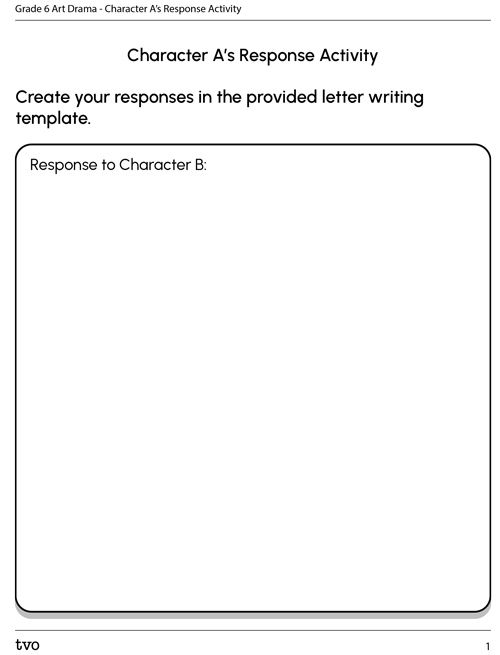Minds On
Warm up

Don’t forget to do your safety check!
Warm Up
Breathe in and out
For our warm-up activity, access this audio clip entitled “Breathing Activity” to learn more about taking deep breaths.
Breathing Activity
Find a comfortable position. Focus your attention on one part of the body at a time.
How does that part of your body feel? If possible, take a deep breath and allow your lungs to expand.
Now, focus your attention on one part of your body. Allow that part to relax before moving on to the next.
As you scan through your body, keep breathing deeply.
Once you have completed the scan, take a moment to stretch.
Drama game

For this drama game, imagine a person flying a large, brown, and scaly fire breathing dragon into the sky.
- What might have happened just before the dragon and rider took to the sky?
- What might happen next?
Create a tableau of the first, second, and third scene. Then, create transitions between each scene to create a drama story.
Press 'Tableau' to access a definition.
A tableau is a frozen picture that someone creates with their body and face to express ideas and/or feelings.
Someone might create one tableau or many tableaux.
If creating a series of tableaux, a transition or specific movement is used to go from one tableau to the next.
You can also create a detailed written description, an audio description of the scene, or another method of your choice.
Consider adding your work to your drama portfolio.
Let’s get started!
Explore the following image:

- What can you share about the character from this picture?
- What questions do you have about them?
- What questions would you ask them?
Record your ideas using a method of your choice, and share with a partner, if possible.
Action
Get ready, get set…

Perspective
In drama, we can explore multiple perspectives in a role and as audience members.
An actor has the opportunity to take on the role of a character in a play or drama performance.
They might research their character and work with the director and members of the cast and crew to develop their character’s thoughts, feelings, and opinions.
Taking on the role of a character is a special way that we can learn about different perspectives. Being in a role also allows the actor to create relationships with other characters in the drama.
Did You Know?
Did you know?
Each person has their own perspective, a way to experience the world around them. A person’s ideas, feelings, and experiences are all part of their perspective.
As an audience member, we can experience many different actors sharing their characters and their perspectives. An audience has the unique opportunity of experiencing all of these different perspectives to get a whole sense of the drama.
Press the following tabs to access the different types of perspectives.
In first person, the actor is a character in the story and a narrator, who tells the drama story from their perspective.
They share their personal thoughts, feelings, and experiences through dialogue with other characters and monologues to share information with the audience.
Check out the following chart for word clues that signal a story is being told from a first-person perspective.
| I | me | my |
| we | us | our |
In third person, the actor is a narrator, who is not a character in the drama story. The narrator makes observations about different characters in the story and also provides information that the audience might need (e.g., change in scene, special details about different characters, thoughts, etc.). Also, a narrator may use the characters names when they are telling the story.
Check out the following chart for word clues that signal a story is being told from a third-person perspective.
| they | them | theirs |
| she | her | hers |
| he | him | his |
Multiple perspectives

Characters may share their thoughts in dialogue and their internal thoughts with the audience through a monologue.
Additionally, the narrator provides thoughts and opinions about all of the characters in a play or drama production. This is how the audience is provided with multiple perspectives to explore.
Which one?
Choose whether each scenario is first or third person.
Select the correct answer, then press 'Check Answer' to see how you did.
Go!
Whose perspective?
Explore the following character bios.
These three characters are part of a drama story about a Grade 6 class.
In this drama story, all three characters are in the same Grade 6 class.
Character A is giving a presentation in front of the class tomorrow.
Explore the following letters written by Characters B and C, to Character A.
Press the following tabs to access each letter.
Dear Character A,
So, I hear you are giving a big presentation. I’ve got some tips for you.
Try to be more outgoing. (You should share your ideas more in class. That will give you practice.)
When you give your presentation, be confident. (Look at me! I speak up all the time and I have no problem sharing my thoughts.)
I would practise now because you don’t want to freeze up during your big presentation. You want to be confident and prepared!
- Character B
Dear Character A,
I know you have the big presentation coming up and when we had talked before, you mentioned you were feeling nervous. But, I’m here to tell you, don’t worry, you will be great!
After all, you may seem shy in larger groups, but you aren’t shy around me or our other friends. Tap into that feeling. Imagine that it’s a room full of your friends watching you and we are cheering you on! You can do it!
If you get nervous during the presentation, try taking a deep breath. I find that helps sometimes, too.
- Character C
After exploring the letters, what did you learn about Character A?
Record your ideas in a notebook or another method of your choice.
Try It
Let’s imagine!

Think about how Character A might be feeling after receiving the letters from Characters B and C. In the role of Character A, create a response letter to Characters B and C.
Consider:
- How might you respond to Character B? What do you think of their advice?
- How might you respond to Character C? What do you think of their advice?
Complete the Character A’s Response Activity in your notebook or using the following fillable and printable document. If you would like, you can use speech-to-text or audio recording tools to record your thoughts. Consider adding your work to your drama portfolio.

Press the Activity button to access the Character A’s Response Activity.
Activity (Open PDF in a new tab)Consolidation
Making connections

Portfolio
Monologue
A monologue is a long speech by one actor in a drama, intended to provide insight into the character. The actor might use their body, face, and voice to share different feelings, ideas, and thoughts to the audience.
Explore this video entitled “Body, Face, and Voice” to learn more about how actors use body movement, facial expressions, and vocal cues to convey emotion.
Sometimes, an actor might give a monologue to share their perspective on an event, idea, or theme with the audience.
Using your recorded response in the Action section, you will be creating a monologue as Character A. This monologue can take place before or after they give their presentation. In this monologue, you are Character A addressing a theatre audience.
Consider what questions you might ask when you go back into role to help understand the emotions and motivations the character has at this key moment.
Record your questions for your character using a method of your choice. Think about how your character might respond.
Practise your monologue and when you feel ready, present your monologue to a partner, if possible. You may also create an audio or video recording.
Consider adding your monologue to your drama portfolio.

Portfolio
Review your learning
Let’s reflect on the following questions:
- How did it help you to take on the role of Character A after exploring the letters from Characters B and C?
- How might the presentation of one perspective over another change the perception of the audience?
- Why is it important to recognize multiple perspectives in a drama performance?
Record your ideas in a notebook or another method of your choice.
Consider adding your work to your drama portfolio.
Reflection
As you read through these descriptions, which sentence best describes how you are feeling about your understanding of this learning activity? Press the button that is beside this sentence.
I feel…
Now, record your ideas using a voice recorder, speech-to-text, or writing tool.


